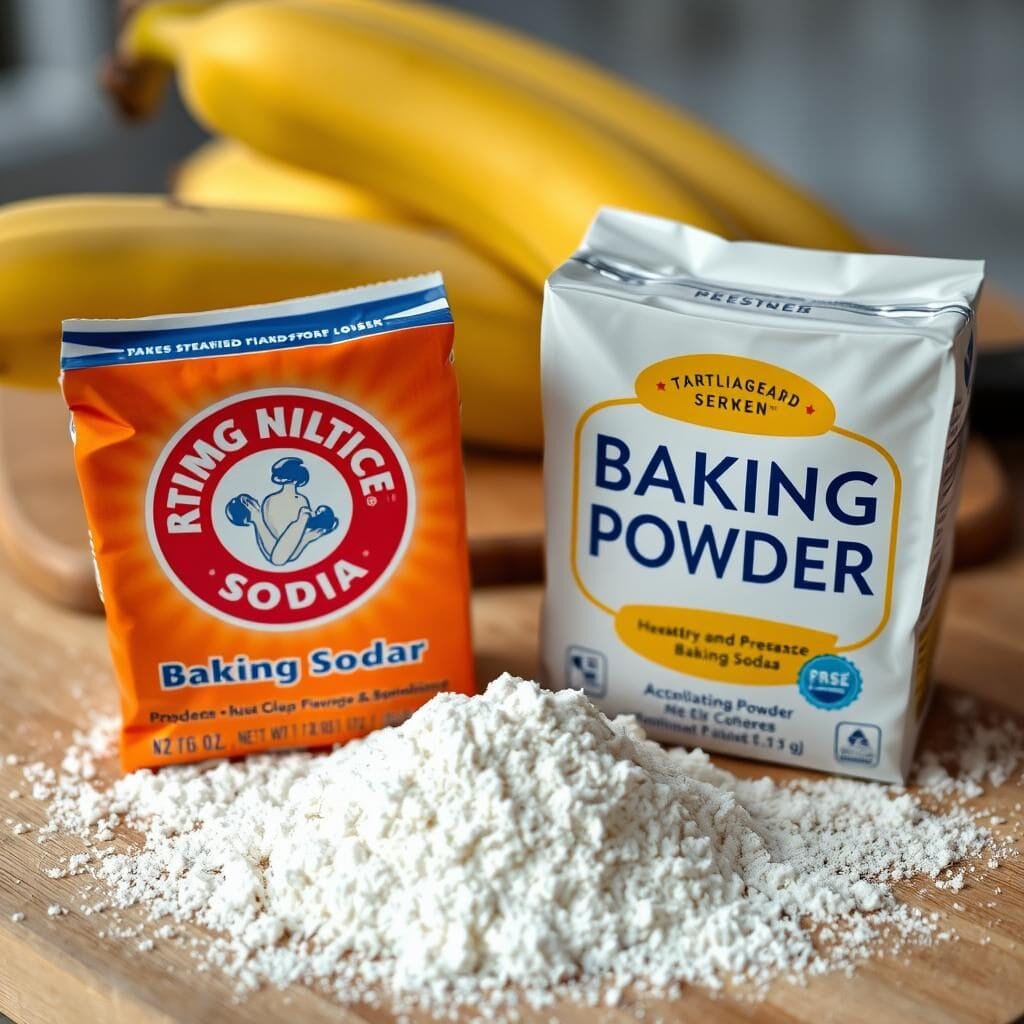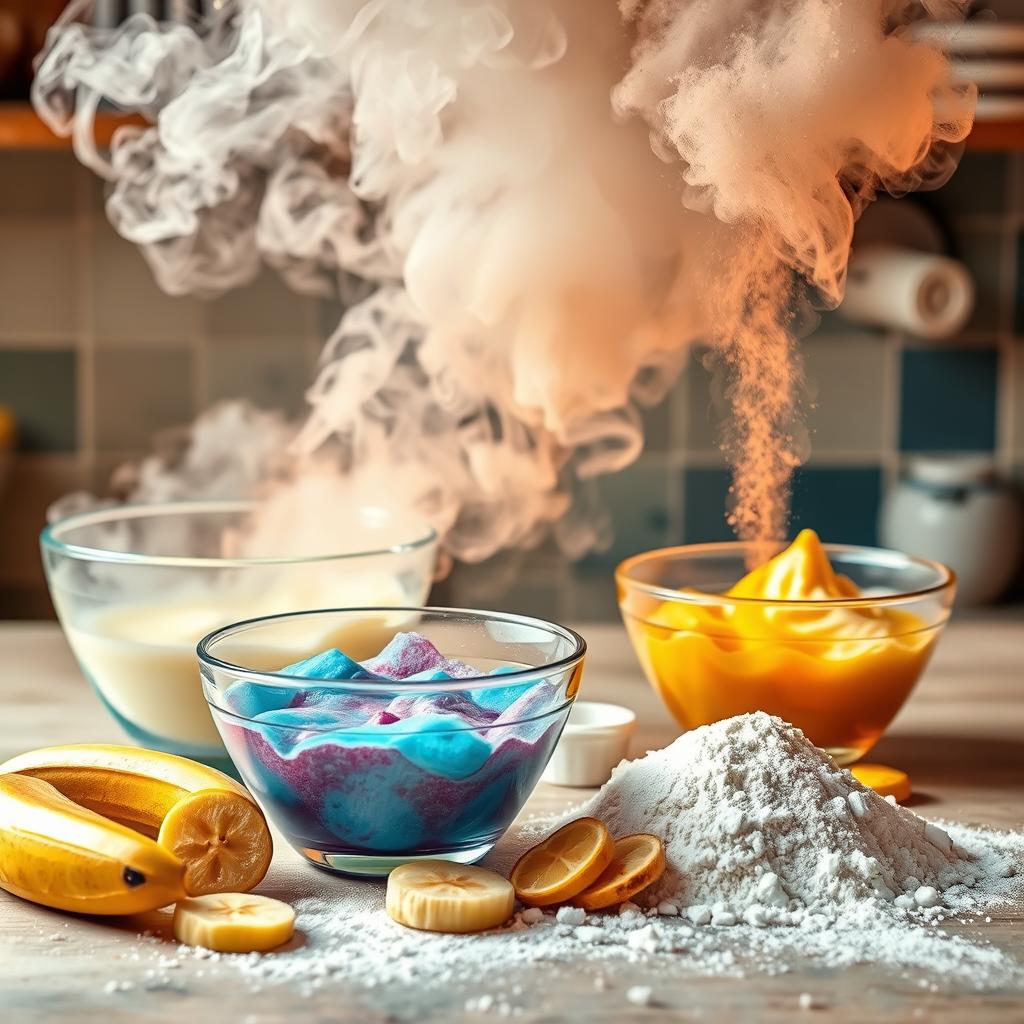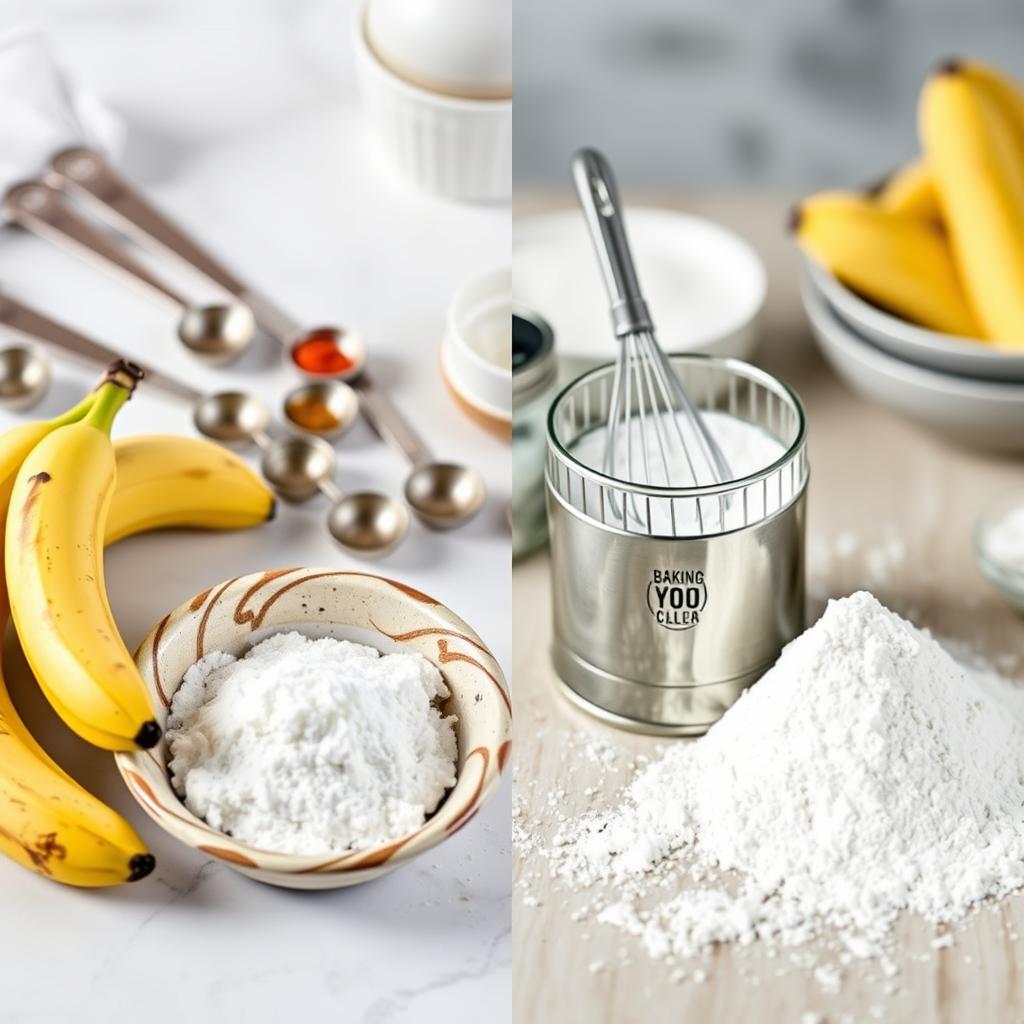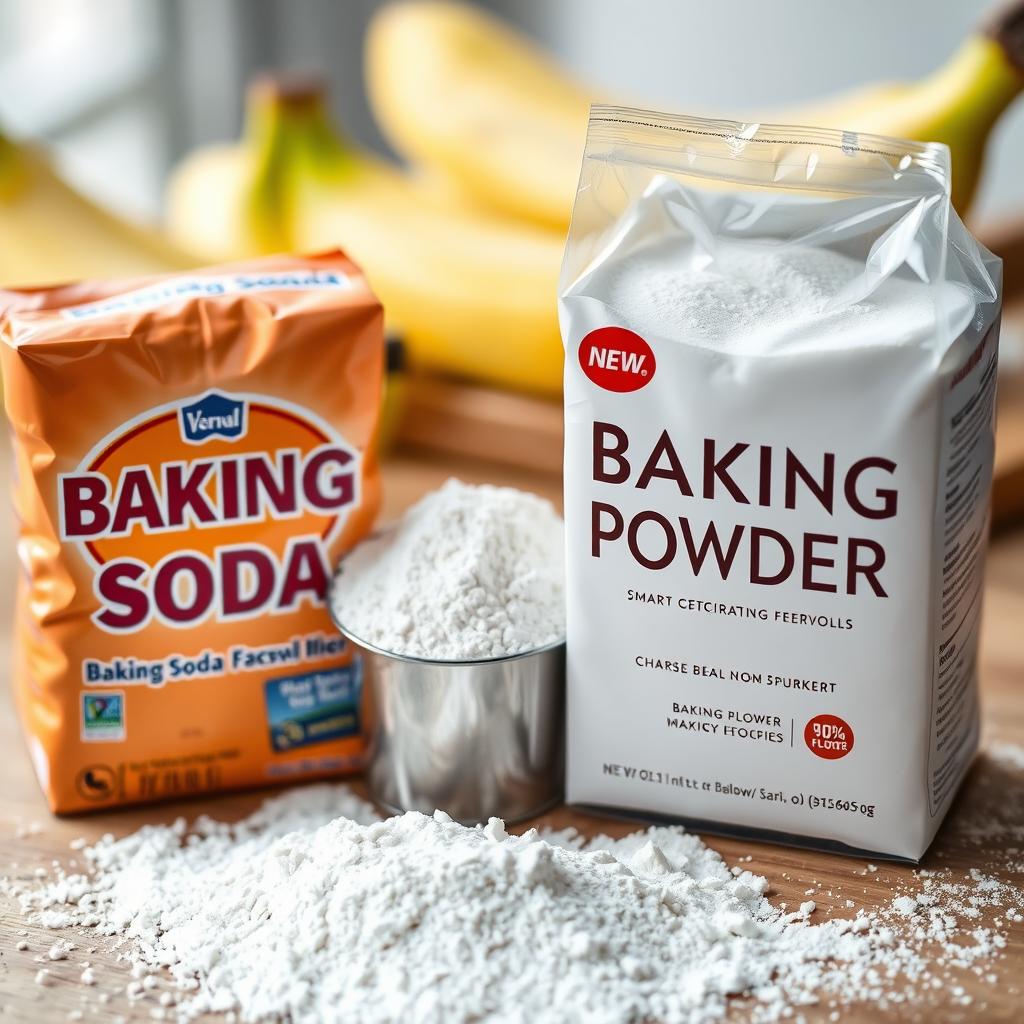Should I use baking soda or baking powder for banana bread?
I’ve spent hours perfecting my banana bread, and the smell and taste are incredible. But I’ve always wondered: which is better, baking soda or baking powder?
This guide is my journey to find out. It’s for both new and experienced bakers. You’ll learn to make the best banana bread ever.

Key Takeaways
- Understand the science behind baking soda and baking powder as leavening agents in banana bread
- Learn how to choose the right leavener for your desired texture and flavor
- Discover the optimal ratios and techniques for using baking soda or baking powder in your banana bread recipe
- Explore the impact of environmental factors, such as altitude and humidity, on leavening success
- Troubleshoot common issues with banana bread rise and texture
Whether you’re a seasoned baker or new to quick breads, this guide will help. You’ll learn to make perfectly risen and delicious banana bread every time.
Understanding Leavening Agents in Banana Bread
Banana bread is a favorite quick bread known for its light and fluffy texture. But have you ever thought about the science behind these rising agents? Let’s explore how baking soda and baking powder work in banana bread recipes.
The Science Behind Rising Agents
Leavening agents make the bread rise by creating gases. Baking soda, or sodium bicarbonate, mixes with acidic ingredients like bananas. This mix releases carbon dioxide, creating air pockets that make the bread light and airy.
How Leaveners Affect Texture
The type and amount of leavener used change the banana bread’s texture. Baking soda makes a coarser crumb, while baking powder results in a finer texture. Knowing this helps you adjust your recipe for the perfect texture.
Chemical Reactions in Baking
Baking is full of amazing chemical reactions. As the batter heats, leavening agents transform, releasing gases. This creates the bread’s rise and texture. Mastering these chemical reactions is key to baking perfect banana bread.

“The science behind baking is truly fascinating. Understanding how leavening agents work can take your banana bread to the next level.”
Should I Use Baking Soda or Baking Powder for Banana Bread?
Choosing between baking soda and baking powder is key for perfect banana bread. Each ingredient affects how the bread rises and feels. Knowing their differences helps pick the best one for your bread.
Baking soda needs acidic ingredients, like bananas, to work. It creates bubbles that make the dough rise. Baking powder, however, has both baking soda and an acid. This means it can work without extra acid.
| Baking Soda | Baking Powder |
|---|---|
| Reacts with acidic ingredients like bananas | Contains its own acidic compound, no additional acid needed |
| Provides a more pronounced, slightly tangy flavor | Offers a more neutral, subtle flavor |
| Requires precise measurement to avoid a bitter aftertaste | Has a wider margin for error in measurement |
Choosing between baking soda or baking powder depends on what you like. Baking soda gives a strong rise and a tangy taste. Baking powder offers a gentle rise and a milder flavor. Try both to see which you prefer.

The Role of Baking Soda in Banana Bread Making
Baking soda is key in banana bread recipes. It helps the bread rise and gives it a great texture. Knowing how baking soda works with bananas is crucial for making perfect banana bread.
How Baking Soda Interacts with Bananas
Bananas have a natural acid that reacts with baking soda. This reaction makes carbon dioxide bubbles. These bubbles make the bread light and airy.
The right mix of banana acidity and baking soda’s alkalinity is important. It helps get the perfect texture in your banana bread.
Proper Measurement Techniques
- Measuring baking soda correctly is very important. Too much can make the bread taste bitter and feel coarse.
- Start with 1/2 teaspoon of baking soda for every 1 cup of mashed bananas. You can adjust this based on your recipe and taste.
Signs of Too Much Baking Soda
- An overly domed or peaked top on the banana bread, indicating excessive rise and expansion.
- A gritty, coarse texture throughout the loaf, rather than a soft, tender crumb.
- A distinct, bitter or metallic aftertaste that overwhelms the natural banana flavor.
Understanding baking soda’s role in banana bread is key. It ensures your bread is moist, tender, and full of flavor. Try different amounts to find what works best for you.
Learn more about the differences between baking soda and baking powder for banana.
“Baking soda is the secret to achieving that perfectly light and airy texture in your banana bread.”
Baking Powder: When and Why to Use It
Baking powder is great for quick breads like banana bread. It’s different from baking soda because it has both an acid and a base. This makes it work well on its own, without needing extra ingredients.
It’s especially good when your recipe doesn’t have enough acid. For example, if you’re making banana bread without buttermilk or yogurt, baking soda might not work right.Baking powder helps your bread rise better and results in a fluffier texture. It also allows for more flavor experimentation, as it has a neutral taste. In contrast, baking soda can sometimes give the bread a metallic flavor.
This lets the banana’s sweetness come through more.
| Characteristic | Baking Soda | Baking Powder |
|---|---|---|
| Activation | Requires acidic ingredients | Self-contained, reacts with moisture |
| Flavor Impact | Slightly metallic or bitter | Neutral |
| Appropriate for Recipes | Acidic ingredients present | Insufficient acidic ingredients |
Knowing when to use baking powder can open up new flavors and textures in your banana bread.
Combining Both Leaveners: Best Practices
Using both baking soda and baking powder in banana bread can make a big difference. Baking soda and baking powder work together to make your batter rise and have a great texture. Knowing the right amounts and when to use them can help you make a banana bread that’s fluffy and well-risen.
Optimal Ratios for Perfect Rise
The best mix for banana bread is 1:2. Use 1 teaspoon of baking soda for every 2 teaspoons of baking powder. This mix creates a perfect balance, helping your bread rise evenly and have a great texture.
Timing and Temperature Considerations
Timing is key when mixing leavening agents. Baking soda works fast, reacting to the bananas’ acidity. Baking powder needs heat to activate. Add baking soda first, then baking powder before baking. This way, both agents work well together, making your banana bread rise perfectly.
The oven’s temperature is also important. Baking at the right temperature helps the leavening agents do their job. This leads to a light and airy banana bread.
Common Mistakes with Leavening Agents
Baking soda and baking powder are key for a great rise in your banana bread recipe. Even skilled bakers can make mistakes with these ingredients. Let’s look at common errors and how to avoid them for fluffy banana bread.
One big mistake is using too much baking soda. Too much can make your bread taste bitter and feel dense. It’s important to measure it right, following the recipe closely.
- Carefully measure baking soda, avoiding heaping or packed measurements.
- Ensure your baking soda is fresh and not expired, as it loses potency over time.
- Adjust baking soda quantity based on the ripeness of your bananas – riper bananas require less soda.
Another mistake is not activating the baking powder right. It needs liquid and heat to make your bread light and airy. If you don’t mix it well or bake at the right temperature, your bread will be dense.
- Thoroughly combine baking powder with the wet ingredients before adding dry ingredients.
- Ensure your oven is preheated to the correct temperature before baking.
- Don’t overmix the batter, as this can cause the baking powder to lose its effectiveness.
| Common Mistake | Impact on Banana Bread | Solution |
|---|---|---|
| Using too much baking soda | Bitter, metallic taste, dense texture | Measure baking soda precisely, adjust based on banana ripeness |
| Failing to activate baking powder | Flat, dense texture | Mix baking powder thoroughly with wet ingredients, bake at correct temperature |
Avoiding these mistakes with baking soda and baking powder will help you make perfect banana bread every time.
“Mastering the use of leavening agents is the key to creating the ultimate banana bread texture.”
Impact of Leaveners on Banana Bread Flavor
Choosing the right leavening agent is key for quick breads like banana bread. The mix of baking soda and baking powder can change the taste a lot.
Taste Differences Between Soda and Powder
Baking soda gives banana bread a slightly alkaline taste. This taste is more noticeable if the soda isn’t balanced with the bananas’ acidity. Baking powder, with its acidic and basic parts, makes the bread taste more neutral. This lets the bananas’ sweetness stand out.
Achieving the Perfect Balance
To get the best banana bread, mix baking soda and baking powder. Baking soda makes the bread tender and moist. Baking powder helps it rise without hiding the banana taste. It’s all about the right mix and measurements.
| Leavening Agent | Flavor Impact | Recommended Usage |
|---|---|---|
| Baking Soda | Slightly alkaline, can overpower banana flavor | Use in moderation, balance with acidic ingredients |
| Baking Powder | Neutral, allows banana flavor to shine | Use as primary leavening agent for optimal banana taste |
Knowing how leaveners affect banana bread flavor lets you make a perfect loaf. It will be sweet and delicious, with the bananas’ taste in the spotlight.
Storage and Shelf Life of Leavening Agents
Keeping your baking soda and baking powder in good shape is key for great baking. Knowing how these leavening agents work can help you keep them fresh. This way, you’ll always have what you need for the perfect banana bread.
For baking soda, store it in an airtight container in a cool, dry spot. Humidity can make it clump and lose its power. It’s best to get new baking soda every 6 to 12 months for the best results.
Baking powder has a shorter shelf life. Use it within 6 to 12 months after opening. Make sure it’s in a sealed container, away from moisture and heat. This prevents it from losing its leavening power too soon.
- Store baking soda in an airtight container in a cool, dry place.
- Replace baking soda every 6 to 12 months for best results.
- Keep baking powder in a tightly sealed container, away from moisture and heat.
- Use baking powder within 6 to 12 months of opening the container.
By following these easy storage tips, your leavening agents will always be ready. This means you’ll always get that light and fluffy banana bread you love.
Troubleshooting Banana Bread Rising Issues
Getting your banana bread to rise perfectly can be tricky. You might use baking soda, baking powder, or both. Knowing what goes wrong and how to fix it helps your bread rise every time.
A flat banana bread can be a big disappointment. It might happen if you mix the batter too much, add too much liquid, or don’t let it rise enough. To fix this, mix gently and avoid stirring too much. Also, adjust the liquid to get the right batter consistency.
Another problem is when one side of the loaf rises more than the other. This could be because your oven isn’t heating evenly or where you put the pan. Try rotating the pan halfway through baking and make sure your oven is working right.
| Common Banana Bread Rising Issues | Potential Causes | Solutions |
|---|---|---|
| Flat or Sunken Loaf | – Overmixing the batter – Using too much liquid – Insufficient rising time | – Mix ingredients gently – Adjust liquid ingredients – Allow proper rising before baking |
| Uneven Rising | – Uneven oven temperature – Incorrect pan placement | – Rotate pan during baking – Ensure oven is properly calibrated |
| Tough or Dense Texture | – Overusing baking soda or powder – Incorrect ingredient ratios | – Measure rising agents precisely – Adjust ingredient proportions |
A tough or dense banana bread might come from too much baking soda or powder, or wrong ingredient amounts. Make sure to measure the rising agents right and adjust the other ingredients to get the right texture.
By fixing these common banana bread rising problems, you can make sure your quick breads are always light and fluffy. With a bit of practice and paying attention to details, you’ll soon be a pro at making banana bread.
Environmental Factors Affecting Leavening Success
Baking the perfect banana bread requires knowing how environment affects leavening. Altitude and humidity play big roles in the rising process. They can change your banana bread’s texture and how it rises.
Altitude Considerations
Baking at high altitudes is tricky for leavening. Lower air pressure means water boils at a lower temperature. This makes carbon dioxide from baking soda or powder escape faster. Your banana bread might not rise as much.
To fix this, you might need to use less baking soda or powder. You could also add more liquid to keep the right texture.
Humidity Effects
Humidity affects leavening too. In humid air, baking soda or powder can soak up moisture. This makes them less effective in creating the needed chemical reactions for a good rise.
To fight this, use a bit less leavening agent. Make sure your ingredients are at the right temperature before mixing.
Knowing how environment impacts leavening helps you adjust your banana bread recipe. This way, you can get great results, even in different kitchen conditions.
Conclusion
Choosing between baking soda and baking powder is key for the perfect banana bread. We’ve looked into the science behind these agents. We’ve also talked about how they affect the bread’s texture and taste.
Whether you choose baking soda, baking powder, or both, knowing their roles is crucial. This knowledge helps you get the right rise, texture, and flavor in your banana bread. With the right measurements and adjustments, you can make loaves that everyone will love.
As you keep baking, remember that the perfect banana bread is just a step away. By learning how to use leavening agents well, you’ll make a delicious banana bread recipe. Your loved ones will crave it time and time again. Happy baking!

